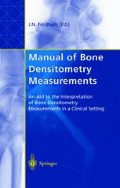Abstract
Since the discovery of X-rays by Röntgen in November 1895 there has been interest in utilising them for the examination of bone. In fact as early as January 1896 the first paper appeared which contained a radiograph. There can be little doubt as to the utility of radiographs in the examination of the skeleton, in particular for the location of fractures and dislocations. Plain radiographs also have a role in the assessment of bone mineral density; advanced osteopenic change or established osteoporosis can easily be detected using, for example, lateral views of the thoracolumbar spine. However, many problems have been found in using this approach. Many attempts have been made to quantify bone mineral from images on radiographic film starting in the 1930s with the work of the American dentist Hodge. Together with his co-workers he examined many variables likely to affect the measurement of bone mineral content (BMC) using direct radiographic methods. In the late 1930s a system which shone a collimated beam of light through a radiograph was used by Pauline Mack to obtain quantitative values from radiographs. This system, albeit modified, was in use into the early 1970s when it was used for measuring the bones of astronauts who had undergone weightlessness during space flight. In 1951 it was pointed out by Ardran that bone destruction could not be shown on radiographs as the images appeared normal until a loss of BMC of the order of 20-30% was present. He also demonstrated the poor reproducibility of the plain film methodology. A need was established for an imaging modality, which was capable of producing not just useful images of the bone anatomy, but also quantitative data that was not subject to the limitations of work based around the use of radiographs. In 1963 a direct method of measuring BMC was developed by Cameron and Sorenson and was used to quantify the loss of bone due to osteoporosis in the forearm bones. This technique known as single photon absorptiometry made the reproducible measurement of bone mineral content a reality. This technique and others that were developed from it is examined in more detail in the section that follows.
Access this chapter
Tax calculation will be finalised at checkout
Purchases are for personal use only
Preview
Unable to display preview. Download preview PDF.
References
Hodge HC, vanHuysen G, Warren SL (1935) Factors influencing the quantitative measurement of the Roentgen ray absorption of tooth slabs. Am J Roentgenol 34:523–528.
Mack PB, Vogt FB (1939) A method for estimating the degree of mineralisation of bones from tracings of roentgenograms. Science 89:467.
Ardran GM (1951) Bone destruction not demonstrable by radiography. Br J Radiogr 24:107.
Cameron JR, Sorenson J (1963) Measurement of bone mineral in-vivo: an improved method. Science 142:230–234.
Reed GW (1966) Measurement of bone mineralisation from the relative transmission of 241 Am and 137Cs radiation. Phys Med Biol 11:174.
Krokowski E (1970) Calcium determination in the skeleton by means of X-ray beams of different energies. In Jelliffe AM, Strickland B (eds) Symposium ossium, Livingstone, Edinburgh.
Cann CE, Genant HK (1980) Precise measurement of vertebral mineral content using computed tomography. J Comput Assist Tomogra 4:493–500.
Schlenker RA, vonSeggen WW (1976) The distribution of cortical and trabecular bone mass along the lengths of the radius and ulna and the implications for in-vivo bone mass measurements. Calcif Tissue Res 20:41–52.
Langton CM (1987) Critical analysis of the ultrasonic interrogation of bone and future developments. In: Palmer SB, Langton CM (eds) Ultrasonic studies of bone, IOP Publishing, Bristol, pp 73–89.
Ouyang X, Selby K, Lang P, et al. (1997) High resolution magnetic resonance imaging of the calcaneus: age related changes in trabecular structure and comparison with dual X-ray absorptiometry measurements. Calcif Tissue Int 60:139–147.
Singh M, Nagrath AR, Maini PS (1970) Changes in trabecular pattern of the upper end of the femur as an index of osteoporosis. J Bone Joint Surg 52A:457–467.
WHO (1994) Assessment of fracture risk and its application to screening for postmenopausal osteoporosis. WHO Technical Report Series 843, WHO, Geneva.
Wahner HW, Fogelman I (1999) The evaluation of osteoporosis: dual energy x-ray absorptiometry in clinical practice. Martin Dunitz, London.
Pearson D, Cawte SA (1997) Long-term quality control of DXA: a comparison of Shewart rules and Cusum charts. Osteoporosis Int 7:338–343.
Garland SW, Lees B, Stevenson JC (1997) DXA longitudinal quality control: a comparison of inbuilt quality assurance, visual inspection, multi-rule Shewart charts and Cusum analysis. Osteoporosis Int 7:231–237.
Bauer DC, Gluer CC, Cauley JA et al. (1997) Broadband ultrasound attenuation predicts fractures strongly and independently of densitometry in older women. A prospective study. Arch Int Med 157:629–634.
Hans D, DArgent-Molina P, Scott AM et al. (1996) Ultrasonographic heel measurements to predict hip fracture in elderly women. The EPIDOS prospective study. Lancet 348:511–514.
Genant HK, Grampp S, Gluer CC et al. (1994) Universal standardisation for dual X-ray absorptiometry: Patient and phantom cross-calibration results. J Bone and Miner Res 9:1503–1514.
Looker AC, Wahner HW, Dunn WL et al. (1995) Proximal femur bone mineral levels of US adults. Osteoporosis Int 5:389–409.
Truscott JG, Devlin J, Emery P (1996) Imaging techniques. 2 Modern methods. Baillieres Clin Rheumatol 10.
Woolf AD, Dixon AStJ (1988) Osteoporosis: a clinical guide. NMartin Dunitz: London.
Palmer SB, Langton CM (1987) Ultrasonic studies of bone. IOP Publishing: Bristol.
Editor information
Editors and Affiliations
Rights and permissions
Copyright information
© 2000 Springer-Verlag Berlin Heidelberg
About this chapter
Cite this chapter
Truscott, J.G. (2000). Measurement of Bone Density: Current Techniques. In: Fordham, J.N. (eds) Manual of Bone Densitometry Measurements. Springer, London. https://doi.org/10.1007/978-1-4471-0759-0_2
Download citation
DOI: https://doi.org/10.1007/978-1-4471-0759-0_2
Publisher Name: Springer, London
Print ISBN: 978-1-4471-1196-2
Online ISBN: 978-1-4471-0759-0
eBook Packages: Springer Book Archive

